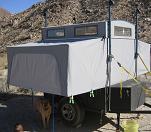I had to look long & hard for this tool when I was wiring a 1500 W inverter into my truck. The big #2 and #4 cables that can feed an inverter like this can be purchased with pre-crimped terminals, but the assemblies are expensive compared to the cost of the materials, plus you are limited to the dimensions you can buy. Home Depot sells a rather stiff #2 and #4 cable, and crimp-on lugs for #4, electric supplies sell all kinds of lugs.
The cheapest tool you can buy to crimp battery terminals to this size cable can be purchased from Fastenal, which has branches all over the country. It's $19 at this time, I bought it at Christmas for $12. It takes a couple of weeks to get to you.
There are lugs you can hammer on directly, for $9 each.
Lastly, there are aluminum lugs that fasten to cables with set screws, for $1-2 each. They tend to have rather small mounting holes & their dimensions may not allow for use on some battery and inverter lugs.
The best quality inverters I have seen come with built-in cable receptables complete with set screws, you simply slip in the bare cable and tighten down the set screw, no lugs or terminals of any kind are necessary.
Hammer-driven battery cable crimper, cable lugs, inverters
10 posts
• Page 1 of 1
The crimp-on lugs are also quite easy to solder on. I tend to crimp them a bit with a hammer in a chunk of angle (kinda like the $20 tool, but alot more redneck....)
Then I stick the lug in a vice, heat it up with my propane torch, and fill the sucker with solder. (use electrical solder, not plumbing solder). If I'm in the mood to care about appearance, I'll stick some heatshrink on the terminal to make it look nice.
Takes me all of 30 seconds or so to put on a lug.
Then I stick the lug in a vice, heat it up with my propane torch, and fill the sucker with solder. (use electrical solder, not plumbing solder). If I'm in the mood to care about appearance, I'll stick some heatshrink on the terminal to make it look nice.
Takes me all of 30 seconds or so to put on a lug.
-- Jeff --
-

jeep_bluetj - Teardrop Master
- Posts: 274
- Images: 17
- Joined: Tue Oct 23, 2007 4:13 pm
- Location: SoCal

 Being compulsively specific, I post the details
Being compulsively specific, I post the details